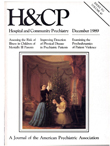Motor Phenomena in Benzodiazepine Withdrawal
Abstract
Chronic use of benzodiazepines, the most widely prescribed of all psychotropic medicines, may lead to severe symptoms of withdrawal when the drugs are discontinued. The authors describe two cases of benzodiazepine withdrawal accompanied by unusual muscle activity. The neurologic mechanism for the motor abnormalities appears to be marked disinhibition of subcortical motor areas normally inhibited by gamma-aminobutyric acid. The motor phenomena may persist long after the more common signs of withdrawal have resolved and, if unrecognized, can lead to such misdiagnoses as drug seeking, conversion, hysteria, or malingering.
Access content
To read the fulltext, please use one of the options below to sign in or purchase access.- Personal login
- Institutional Login
- Sign in via OpenAthens
- Register for access
-
Please login/register if you wish to pair your device and check access availability.
Not a subscriber?
PsychiatryOnline subscription options offer access to the DSM-5 library, books, journals, CME, and patient resources. This all-in-one virtual library provides psychiatrists and mental health professionals with key resources for diagnosis, treatment, research, and professional development.
Need more help? PsychiatryOnline Customer Service may be reached by emailing [email protected] or by calling 800-368-5777 (in the U.S.) or 703-907-7322 (outside the U.S.).



